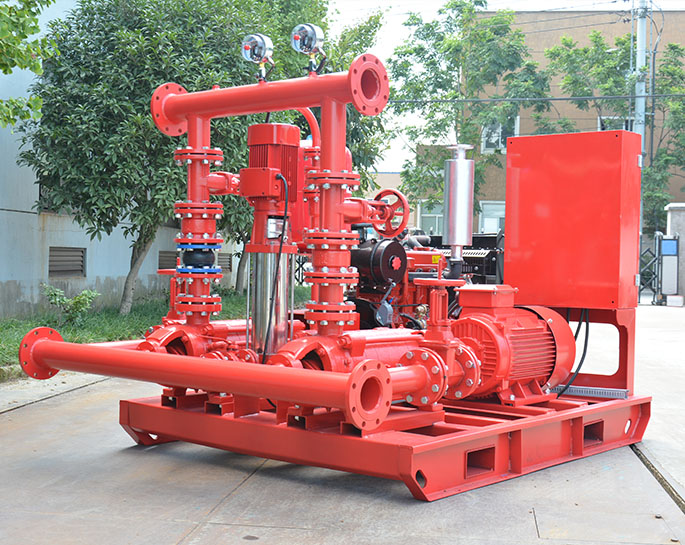Precautions before starting the fire pump
Jul 03, 2023
Share:
Before starting a fire pump, it is essential to take certain precautions to ensure safe and proper operation. Here are some important precautions to follow:
Familiarize Yourself with the System: Understand the layout and operation of the fire protection system and the fire pump. Review the manufacturer's instructions, system documentation, and any applicable codes or regulations.
Conduct Visual Inspection: Inspect the fire pump and its components for any signs of damage, leaks, or obstructions. Check the suction and discharge connections, control panel, motor or engine, and other relevant parts.
Ensure Proper Water Supply: Verify that the water supply source is available and adequate for the fire pump operation. Check the suction line for any debris or blockages that could affect water flow.
Secure Power Source: If the fire pump is electrically driven, ensure that the power source is properly connected, grounded, and rated for the pump's requirements. Verify that all electrical connections are secure and in good condition.
Check Priming (if applicable): If the fire pump requires priming, ensure that the pump and suction piping are properly primed before starting. Follow the manufacturer's instructions for priming procedures.
Verify Valve Positions: Check the positions of all necessary valves, including isolation valves, check valves, and pressure relief valves. Ensure that the valves are in the correct positions for normal operation.
Test Alarms and Safety Devices: Verify that alarms, pressure gauges, and other safety devices are in working order. Test the alarm system to ensure that it activates correctly when needed.
Review Control Panel Settings: Check the control panel settings and adjust them as necessary. Ensure that the control switches, starters, and other control components are in the appropriate positions for starting the fire pump.
Notify Relevant Parties: Inform the appropriate personnel, such as the fire department or building management, that you are about to start the fire pump. This ensures coordination and communication during the pump operation.
Follow Start-up Procedure: Follow the manufacturer's recommended start-up procedure for the fire pump. This may involve activating the pump, monitoring pressure and flow, and gradually bringing the pump up to its full operating speed.
It is crucial to consult the specific guidelines provided by the manufacturer of the fire pump and adhere to any local regulations or requirements when starting the pump. Regular maintenance and periodic testing should also be performed to ensure the fire pump's continued reliability and effectiveness.

Familiarize Yourself with the System: Understand the layout and operation of the fire protection system and the fire pump. Review the manufacturer's instructions, system documentation, and any applicable codes or regulations.
Conduct Visual Inspection: Inspect the fire pump and its components for any signs of damage, leaks, or obstructions. Check the suction and discharge connections, control panel, motor or engine, and other relevant parts.
Ensure Proper Water Supply: Verify that the water supply source is available and adequate for the fire pump operation. Check the suction line for any debris or blockages that could affect water flow.
Secure Power Source: If the fire pump is electrically driven, ensure that the power source is properly connected, grounded, and rated for the pump's requirements. Verify that all electrical connections are secure and in good condition.
Check Priming (if applicable): If the fire pump requires priming, ensure that the pump and suction piping are properly primed before starting. Follow the manufacturer's instructions for priming procedures.
Verify Valve Positions: Check the positions of all necessary valves, including isolation valves, check valves, and pressure relief valves. Ensure that the valves are in the correct positions for normal operation.
Test Alarms and Safety Devices: Verify that alarms, pressure gauges, and other safety devices are in working order. Test the alarm system to ensure that it activates correctly when needed.
Review Control Panel Settings: Check the control panel settings and adjust them as necessary. Ensure that the control switches, starters, and other control components are in the appropriate positions for starting the fire pump.
Notify Relevant Parties: Inform the appropriate personnel, such as the fire department or building management, that you are about to start the fire pump. This ensures coordination and communication during the pump operation.
Follow Start-up Procedure: Follow the manufacturer's recommended start-up procedure for the fire pump. This may involve activating the pump, monitoring pressure and flow, and gradually bringing the pump up to its full operating speed.
It is crucial to consult the specific guidelines provided by the manufacturer of the fire pump and adhere to any local regulations or requirements when starting the pump. Regular maintenance and periodic testing should also be performed to ensure the fire pump's continued reliability and effectiveness.







